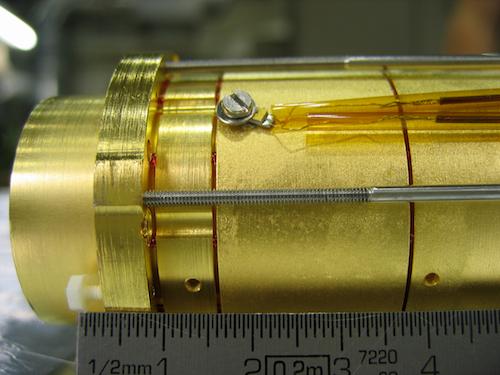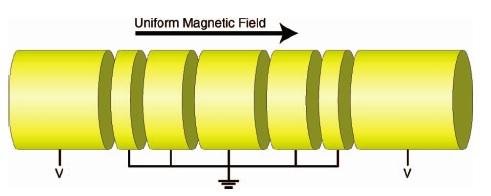The charged particle trap, capable of holding electrons, positrons and antiprotons in a vacuum.
The ALPHA electrode stack is comprised of 35 electrodes. Made from aluminum and plated with gold, the electrodes are 36.6mm to 44.6mm in diameter and have varying lengths. The trap electrodes are mounted inside of a vacuum chamber surrounded by a liquid helium cryostat. Because they are individually wired and insulated from one another, the voltage applied to each electrode can be controlled. This allows the shape of the potentials inside of the trap to be known precisely

Three of these electrodes are outfitted for high voltage and are used in the capture of antiprotons and positrons. Additionally, two electrodes are azimuthally segmented. A sinusoidal voltage can be applied to each segment, where each voltage is phase shifted from the voltage applied to the segment before it. This generates an electric field, which applies a torque on the confined plasma and causes it to compress. In ALPHA, this technique is nicknamed the ‘rotating wall’, and is used to compress both positron and antiproton plasmas. For antihydrogen formation, the colder, denser and smaller a plasma is, the better.
The trap electrodes are divided into three groups, each playing a different role in the process of producing and trapping antihydrogen: the catching trap, the positron electrodes, and the mixing trap.
The catching trap is the region in which antiprotons are received from CERN’s Antiproton Decelerator (AD) (ELENA from 2021). During the time that ALPHA has access to the AD beam, one ‘shot’ of approximately 3x107 antiprotons at an energy of 5.3 MeV is delivered to the apparatus every 100 seconds. The particles pass from the AD through a thin foil degrader (~0.2mm) and into the ALPHA catching trap at energies distributed from 0 to around 1 MeV. At this point, a voltage is applied to one of the electrodes, creating a potential barrier. Particles at higher energies escape and annihilate, but the lower energy particles cannot overcome this barrier. When a second high voltage is quickly applied to a nearby electrode, the lower energy antiprotons find themselves caught in a Penning-Mamlberg trap at around 4 keV. Try trapping antihydrogen yourself!
Even though they can now be trapped, the antiprotons are still too energetic for antihydrogen formation. The antiprotons are held in the catching trap region and are subjected to electron cooling and sometimes evaporative cooling, as well as compression by the rotating wall, before they are finally cold and dense enough for antihydrogen formation.
On the positron side of the electrode stack, positrons are transferred out of the accumulator as a plasma and are held in yet another Penning-Malmberg trap. Any remnant ions are eliminated by applying a heating signal to one of the confining electrodes. The positron plasma is prepared for mixing: the particles cool radiatively and are compressed with the rotating wall, and the final number is controlled by applying a combination of rotating wall fields and evaporative cooling.
What's more?
- For more about Antimatter in general, have a look at the CERN Antimatter page
- Good descriptions of 'How ALPHA works' in detail can be found in the publication section on our website
- Particularly appropriate for students and non-physicists are Cold Antihydrogen: a new frontier in fundamental physics, Antihydrogen for precision tests in physics and Antihydrogen in a bottle
- For experts, a general overview of many of the important aspects can be found in Search for Trapped Antihydrogen


